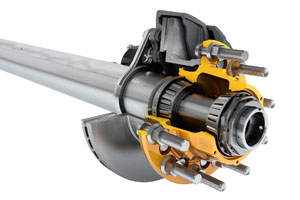Features Editor
SAF-Holland Launches New Air Disc Brakes

The P89 Air Disc Brake Series series is the company’s “next generation” of brakes, Roger Jansen, product manager for trailer axles and suspensions at SAF-Holland, told Transport Topics at a press event here. “For the first time, we have both the base model and a premium model approach.”
The P89 is “positioned up to 40% less than current disc brake systems,” SAF-Holland said. It is available on the SAF CBX air ride and ULX spring ride suspensions.
Air disc brakes have been widely used in Europe, but their cost has been a key reason as to why they have not been widely adopted in North America, executives with SAF-Holland said.
The base model “has been designed with large fleets in mind,” Jansen said. SAF-Holland “leveraged some of our economies of scale from our European operations to drive down the cost of technology and specifically targeting large volume fleets and fleets that are looking for advanced technology in disc brakes at an economical price.”
SAF-Holland S.A. said it is the largest listed supplier to the commercial vehicle market in Europe.
For disc brake models today, about $1,500 is the average “up-charge per axle,” Jansen said. With the P89, SAF-Holland wants to reduce that number about 40%, he said, noting that translates to $700 to $800 per axle.
With the P89, disc brake technology is now “within reach for fleets traditionally spec’ing drum brakes,” SAF-Holland said.
The P89, as well as the P89 Plus greatly improve braking performance, Jansen said.
“Independent tests have shown that the stopping distance of a fully loaded tractor-trailer traveling at 75 mph can be improved as much as 81 feet by replacing convention drum brake systems with air disc brakes on both the truck and trailer,” he said.
Doug Dorn of SAF-Holland,displays companys new P89 air disc brake system in Michigan. More @TransportTopics soon. pic.twitter.com/WuwruUzel7 — Fran Matso Lysiak (@franmlysiak) June 9, 2016
Jansen noted that drum brakes offer “a very simplistic operation” and fleets have been comfortable with them. But fleets are “looking to increase their bottom line; and any technology is going to be judged based on the metric.” Disc brakes “certainly offer that payback but it comes at a certain time period, and fleets are looking to drive down that [return on investment] target.”
He said in North America, some large fleets are very knowledgeable about their cost-per-mile, their total inventory costs down to fractions of a penny.
Jim Fox, vice president and general manager for Pinnacle Express Inc., who was also at the event, said Pinnacle saw sharply reduced maintenance and better performance with SAF-Holland air disc brakes. Pinnacle is “never going back to drum brakes,” Fox said.
Pinnacle transports aviation fuel throughout the Great Lakes and Midwest. It converted its fleet to SAF suspension systems, equipped with air disc brakes five years ago.
Central to the P89 is the SAF SBS 2220 caliper and 430mm diameter by 45 mm thick rotor, the company said, adding that the dual piston caliper applies a more even pressure pattern across the brake lining than competitive single piston designs and the rotor provides 30% more wear volume.
The brake also is standard with a 3.5 inch diameter parallel spindle or an optional lightweight taper spindle configuration, which reduces weight by 10 pounds per axle, SAF-Holland said.
The P89 Plus, meanwhile, is standard with a seven-year maintenance-free bearing system that uses large 89 mm front and rear bearings that are individually sealed and lubricated with high temperature long-life grease. Traditional wheel seals, which are a common source of premature wheel end failure, are eliminated, SAF-Holland said.
SAF-Holland Americas President Steffen Schewerda told Transport Topics that with drum brakes, North America is standardized. In many cases, “We don’t even deliver the wheel-end components for the drum brakes because the market is so highly standardized,” Schewerda said, noting this standardization and competition drove down their prices over the years.



